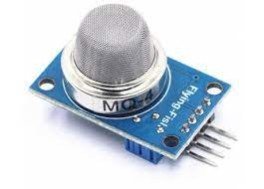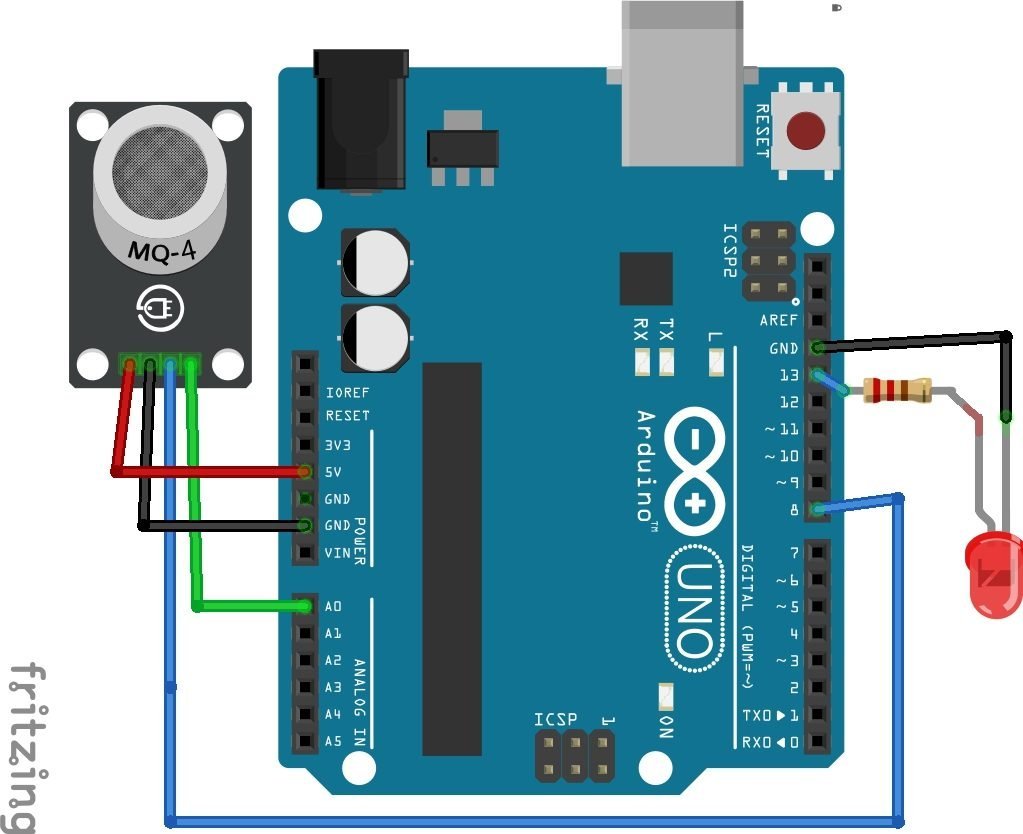








MQ4 GAS SENSOR MODULE
MQ4 Gas sensor is a Metal Oxide Semiconductor (MOS) type Gas Sensor mainly used to detect the Methane (CNG) gas concentration in the air either at home or in industry. This sensor contains a sensing element, mainly aluminum-oxide based ceramic, coated with Tin dioxide, enclosed in a stainless-steel mesh.
₹ 93 ₹149
149



| Made In : | India |
Add FAQ
The MQ4 gas sensor module is a type of metal oxide semiconductor (MOS) sensor designed primarily to detect methane (CH4) and liquefied petroleum gas (LPG), with secondary sensitivity to carbon monoxide (CO) and other gases. It is commonly used in gas leak detection systems, air quality monitoring, and safety applications. Here’s a detailed overview of the MQ4 gas sensor module:
MQ4 Gas Sensor Module Overview:
1. Key Features:
-
Gas Detection:
- Primary Gases: Methane (CH4) and Liquefied Petroleum Gas (LPG).
- Secondary Gases: Carbon monoxide (CO) and other combustible gases.
-
Heating Element:
- Contains a heating element that maintains the sensor's operating temperature, which is crucial for accurate gas detection.
-
Analog Output:
- Provides an analog voltage output that changes proportionally with the concentration of the detected gases. This voltage can be measured to determine gas levels.
-
Digital Output (Optional):
- Some MQ4 modules include a digital output that activates when gas concentration exceeds a predefined threshold, useful for triggering alarms or other responses.
2. Working Principle:
-
Gas Detection:
- The MQ4 sensor detects gases by measuring changes in the resistance of its metal oxide semiconductor material. Exposure to target gases alters the resistance, which is translated into a voltage signal.
-
Heating Process:
- The sensor includes a heating element that heats the sensing material to a consistent temperature, allowing for stable and reliable gas detection.
-
Output Signal:
- The analog output voltage varies with gas concentration. This signal can be read by a microcontroller or ADC to determine the concentration of the target gases.
3. Circuit Connections:
-
Power Supply:
- VCC: Connect to a 5V power source.
- GND: Connect to ground.
-
Analog Output:
- A0: Connect to an analog input pin on a microcontroller or ADC for measuring gas concentration.
-
Digital Output (if available):
- D0: Connect to a digital input pin on the microcontroller. This output is often used to trigger an alert when gas concentration exceeds a set threshold.
-
Heater Control:
- Some modules may include additional pins for controlling the heater. Refer to the datasheet for specific instructions.
4. Applications:
-
Gas Leak Detection:
- Used in safety systems to detect leaks of methane or LPG, providing early warnings to prevent potential hazards.
-
Air Quality Monitoring:
- Applied in systems that monitor indoor or outdoor air quality by detecting concentrations of methane and other gases.
-
Environmental Monitoring:
- Utilized in environmental monitoring systems to ensure safe gas levels and detect changes in gas concentrations.
-
Home Safety:
- Can be used in household safety devices to detect dangerous levels of gas.
5. Calibration:
-
Initial Calibration:
- Begin by exposing the sensor to clean air to establish a baseline resistance for zero gas concentration.
-
Gas Concentration Calibration:
- For accurate measurements, calibrate the sensor with known concentrations of target gases (e.g., methane or LPG). This involves creating a calibration curve based on the sensor’s response to these known levels.
6. Advantages:
-
Versatility:
- Sensitive to multiple gases, including methane, LPG, and CO, making it suitable for various applications.
-
Cost-Effective:
- Provides an affordable solution for gas detection and monitoring.
-
Ease of Integration:
- Simple to integrate with microcontrollers and other electronic systems due to its analog and optional digital outputs.
7. Limitations:
-
Sensitivity to Interference:
- The sensor may respond to other gases or environmental conditions, which can impact accuracy. Proper calibration is crucial for reliable readings.
-
Warm-Up Time:
- Requires a warm-up period to stabilize and provide accurate readings.
-
Limited Lifespan:
- The sensing material can degrade over time, which may affect sensor performance and accuracy.
8. Example Use Case:
Gas Leak Detection System:
- In a gas leak detection system, the MQ4 sensor monitors the concentration of methane or LPG. When the sensor detects a gas concentration above a predefined threshold, the system can trigger an alarm or take action to address the potential leak.
Summary:
The MQ4 gas sensor module is a versatile tool for detecting methane, LPG, and other gases. Its sensitivity and ease of integration make it ideal for applications in gas leak detection, air quality monitoring, and safety systems. Proper calibration and understanding of the sensor’s limitations are essential for achieving accurate and reliable performance. For detailed specifications and connection instructions, refer to the datasheet specific to the MQ4 module.


0 Reviews For this Product












.jpg&width=225&quality=80)
